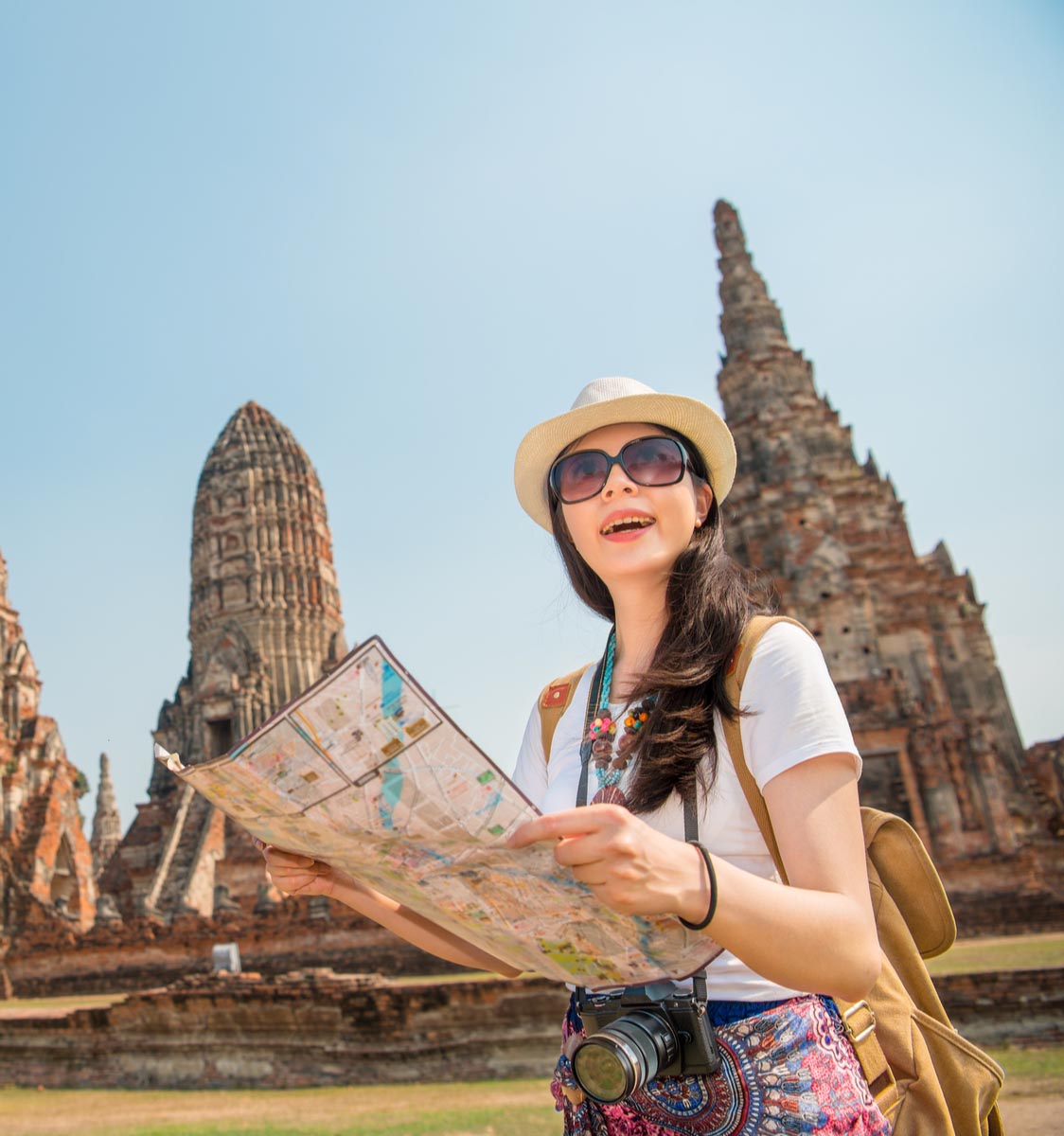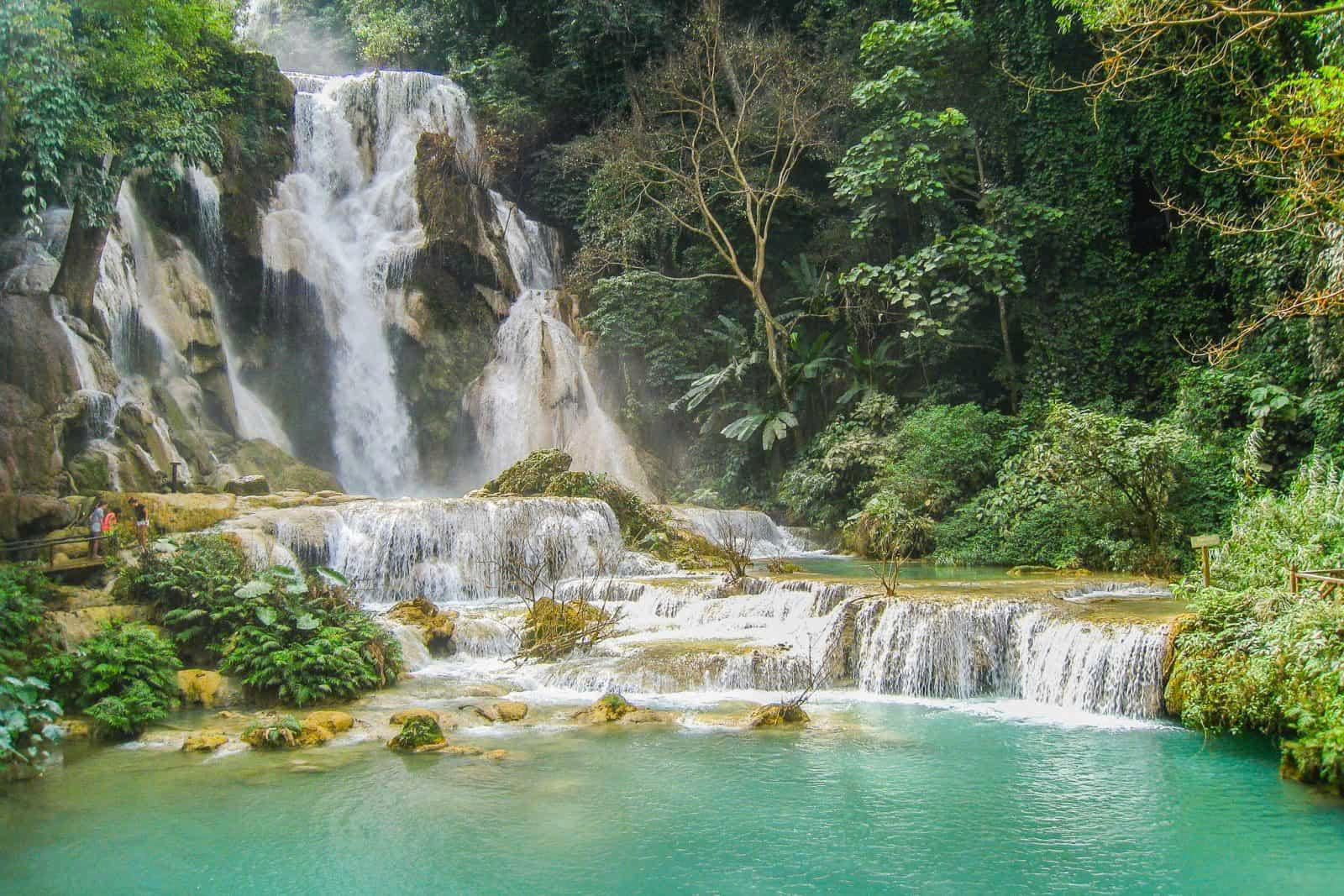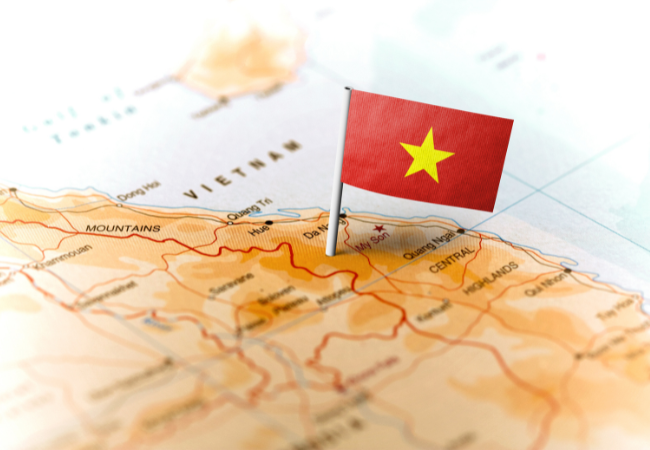Thailand’s New Year Splash – Explore Songkran Festival
New Year celebrations are a vibrant tapestry woven from the threads of diverse cultures around the globe. While Western countries usher in the New Year on January 1st following the Gregorian calendar or the Mahayana lunisolar cycle for other regions like Vietnam and China, Thailand heralds the year's arrival with the joyous Songkran festival. Songkran, also meaning ‘passing’ or ‘approaching’ in Sanskrit, marks the beginning of the traditional Thai New Year, following the Theravada Buddhist calendar. Join VietnamStay to discover the fascinating culture and traditions of the Thais during their biggest festival of the year.

An elephant – Thailand's national animal, in Songkran water splashing festival
I. About the Buddhist Calendar
The Buddhist calendar, originating from ancient India, is unique in how it tracks time. Unlike the fixed January 1st of the Gregorian calendar, the Buddhist New Year varies depending on region and tradition, usually happening around the start of spring. This intricate system combines lunar cycles for months with solar cycles for years, occasionally employing leap months to maintain alignment. While most Buddhist countries use the Gregorian calendar for everyday life, the Buddhist calendar continues to hold significant weight for religious observances and cultural celebrations.
Although sharing similar concepts and regulations, the Buddhist calendar varies in different regions and countries. Countries like China, Vietnam, Japan, and Korea practice Mahayana Buddhism, while Thailand, Myanmar, and Cambodia follow Theravada traditions.
Though both Theravada and Mahayana Buddhism share the core concept of a lunisolar calendar, their specific implementations differ in some interesting ways. This variation in how they calculate lunar cycles means that important Buddhist holidays like the Buddha's birthday, enlightenment, and passing might sometimes fall on different days. For instance, Mahayana countries often begin their year around January or February, while Theravada countries, like Thailand, start theirs in April.
Moreover, Theravada nations usually stick to their calendar practices more consistently within their tradition. On the other hand, Mahayana countries like China and Japan might have more differences in their calendars due to cultural and historical factors. This diversity showcases the depth and complexity of Buddhism, even in something as seemingly simple as keeping track of time.
Although sharing similar concepts and regulations, the Buddhist calendar varies in different regions and countries. Countries like China, Vietnam, Japan, and Korea practice Mahayana Buddhism, while Thailand, Myanmar, and Cambodia follow Theravada traditions.
Though both Theravada and Mahayana Buddhism share the core concept of a lunisolar calendar, their specific implementations differ in some interesting ways. This variation in how they calculate lunar cycles means that important Buddhist holidays like the Buddha's birthday, enlightenment, and passing might sometimes fall on different days. For instance, Mahayana countries often begin their year around January or February, while Theravada countries, like Thailand, start theirs in April.
Moreover, Theravada nations usually stick to their calendar practices more consistently within their tradition. On the other hand, Mahayana countries like China and Japan might have more differences in their calendars due to cultural and historical factors. This diversity showcases the depth and complexity of Buddhism, even in something as seemingly simple as keeping track of time.

Monk pinning traditional flags for Songkran festival
II. When is the Songkran Festival?
The Songkran Festival is an annual event that occurs every April, spanning from the 13th to the 15th of the month.
III. How is Songkran Celebrated in Thailand?
Water is the lifeblood of Songkran, transforming Thailand into a joyous water-warzone! Recent times have amplified this tradition, making the playful throwing of water an iconic symbol of celebration. If you're visiting during Songkran, prepare to be thoroughly drenched. Buckets fly, water pistols every gush, and crowds revel in soaking anyone and everyone in sight.
Yet, amidst the playful chaos, Songkran is deeply rooted in tradition. Family bonds are strengthened as many Thais return to their hometowns to spend time with loved ones. Buddhists honor their faith by visiting temples, pouring water on Buddha images and the hands of monks as a gesture of reverence and respect.
Yet, amidst the playful chaos, Songkran is deeply rooted in tradition. Family bonds are strengthened as many Thais return to their hometowns to spend time with loved ones. Buddhists honor their faith by visiting temples, pouring water on Buddha images and the hands of monks as a gesture of reverence and respect.
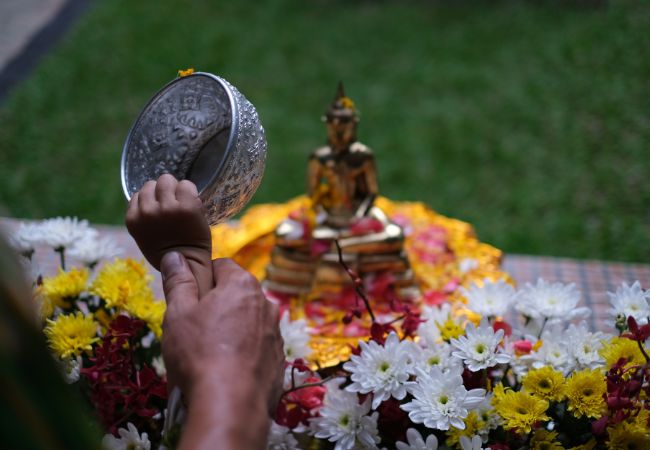
Father and son pouring perfume water on the Buddha statue for good fortune
IV. What Happens on the Three Days of Songkran?
1. Day 1: Songkran Day (April 13th)
The festivities kick off on the first day with the Wat Phra Kaeo Procession, a magnificent spectacle where ornate royal figures carry revered Buddha images through the streets of Bangkok. On this day, the whole country practices the Temple Cleansing Ceremonies, where devotees visit temples to offer alms and perform a ritualistic cleansing of Buddha statues with fragrant water, symbolizing renewal and washing away past transgressions. As the day progresses, the air electrifies with the joyous chaos of water fights. People of all ages arm themselves with buckets, water guns, and hoses, playfully drenching each other in a symbolic act of washing away bad luck and ushering in a fresh start with good fortune. Finally, the day culminates in heartwarming Family Gatherings. Reunions and strengthening bonds take center stage, often accompanied by the beautiful tradition of "Rod Nam Dam Hua." With this tradition, younger generations express gratitude and seek blessings by pouring scented water over their elders' hands or feet.
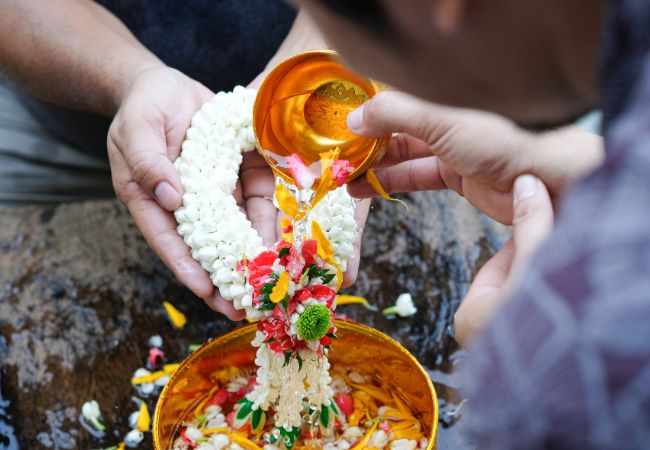
Younger generations pour scented water over elders' hand
2. Day 2: Wan Nao (April 14th)
The second day, Wan Nao, is the celebration of the old Thai New Year’s Eve that takes place on April 14th, when the sun travels between Pisces and Aries. On this day, devotees visit temples to engage in offering to monks, providing food and essential items as a way to accumulate merit and secure blessings for the New Year. This day also witnesses the unique practice of Sand Chedi building on temple grounds. Participants create temporary sand pagodas, symbolically letting go of the past and embracing new beginnings. While the playful water fights may not be as intense as the previous day, the spirit of water play continues throughout the country, adding to the joyous atmosphere.

Sand Chedi building on Songkran day
3. Day 3: Wan Payawan (April 15th)
Wan Payawan, the final day of Songkran on April 15th, carries a solemn yet hopeful spirit. It witnesses the symbolic act of Releasing Animals, where some individuals choose to liberate captive animals like fish or birds, signifying the release of misfortune and bad luck. The day also emphasizes Making Merit, with many participating in visits to temples, offering alms, and engaging in other merit-making activities to secure blessings for the year ahead. While the playful Water Play Winds Down compared to the previous days, remnants of the festive spirit may linger in certain areas, allowing the vibrant memories of Songkran to fade gradually. It is important to note that officially Thai New Year's Day falls on April 15th, marking the culmination of the festive period in many parts of Thailand.
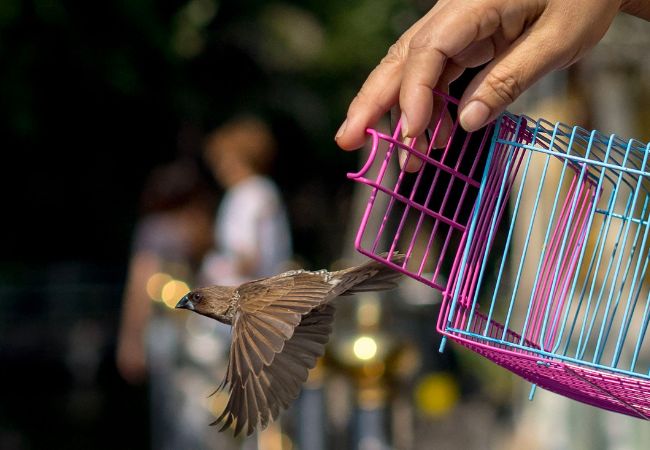
Releasing captive animals symbolizes releasing misfortune and bad luck
4. Additional notices
Amidst the joyful chaos of Songkran, it's important to remember some key points to ensure a respectful and enjoyable experience for everyone. While water splashing is encouraged, avoid targeting monks or individuals wearing white clothing, as it's considered disrespectful. Additionally, Songkran is deeply rooted in family values. Showing respect to elders during family gatherings is an essential aspect of the celebration. Finally, remember that Thailand is a diverse nation, and different regions may have unique customs and traditions specific to their locality. Be mindful and respectful of these local variations to fully immerse yourself in the rich tapestry of Songkran.
V. Songkran – a Festival For All
The Songkran Festival beats at the heart of Thailand, holding immense cultural significance for its people. Yet, its infectious joy and lively atmosphere reach far beyond borders, drawing visitors who plan their journeys around this extraordinary occasion. Songkran embodies inclusivity. Tourists and locals alike become participants in the joyous chaos, with no age or social barrier standing in the way of a good soaking. While stepping out during Songkran ensures a thorough soaking, it also guarantees an experience overflowing with laughter, camaraderie, and the indelible essence of Thai New Year.

Tourists take part in water-splashing activities
VI. Best Cities to Visit on Songkran Festival
Although Songkran is a Nationwide celebration, it is significantly huge and festive in the big countries.
1. Bangkok
The heart of Thailand, Bangkok, erupts in a vibrant celebration during the Bangkok Songkran Splendours Festival, held from April 13th to 15th. The festival's official opening ceremony unfolds at the revered Wat Pho, home to the magnificent gold-plated reclining Buddha. Meanwhile, the bustling Khao San Road, a haven for backpackers from around the world, becomes a hub of thrilling activities like water throwing, ritual bathing of Buddha images, vibrant processions, and captivating performances. And of course, no Songkran celebration is complete without indulging in the tempting array of traditional Thai foods, adding a delicious dimension to the festivities.
2. Chiang Mai
Nestled in the heart of northern Thailand, Chiang Mai explodes with vibrant festivities during Songkran, arguably the country's most spirited celebration. While the official festival dates are April 13th to 15th, Chiang Mai throws the party a day early, kicking off on the 12th with a stunning procession that winds its way through the city. Beyond the iconic water battles, Songkran in Chiang Mai is a feast for the senses. Street vendors tempt with delicious local delicacies, cultural celebrations showcase the rich heritage of the region, and traditional performances enthrall audiences with their artistry. This unique blend of water fights, cultural immersion, and culinary delights makes Chiang Mai's Songkran experience truly unforgettable.

The excitement for the Songkran Festival doesn't exclude anyone
VII. Final Words
Songkran is not only a cultural celebration that highlights the deep-rooted traditions and beliefs of the Thais, but it’s also an outburst of exhilarating energy and vibrancy. Embrace Thailand from the highs of playful water battlefields, and colorful parades, to the contracting moments of being immersed in the fascinating Buddhist culture. Songkran offers an unforgettable journey into the heart of Thai tradition. Plan your trip today and be prepared to get drenched in the spirit of renewal and joy!
For more information on Thailand tours and itineraries, visit our website here!
For more information on Thailand tours and itineraries, visit our website here!

